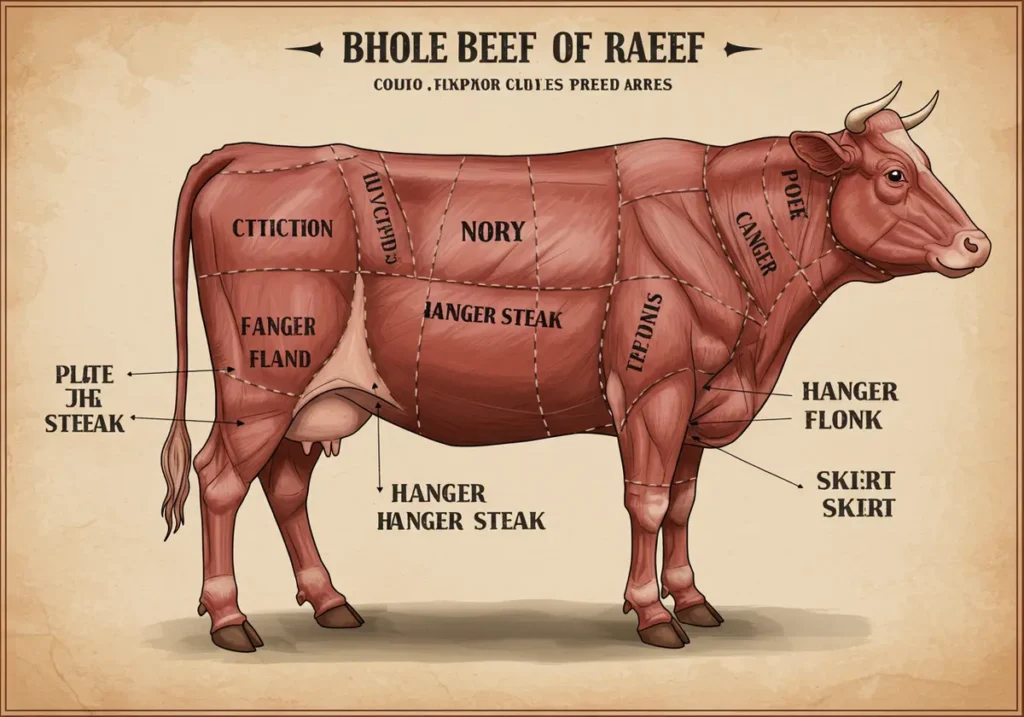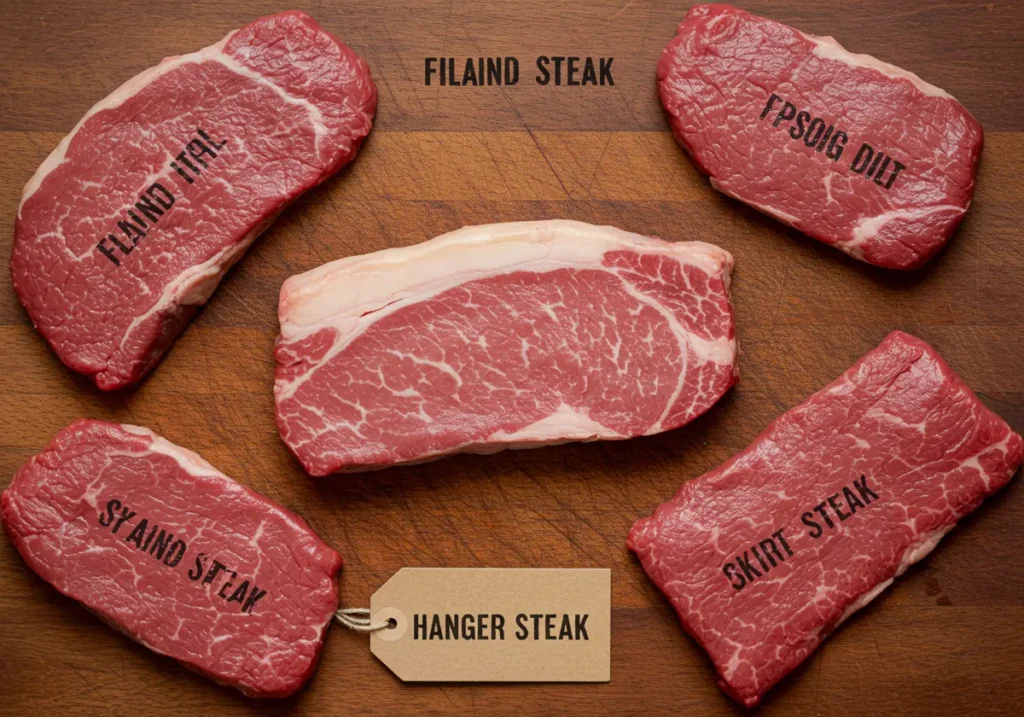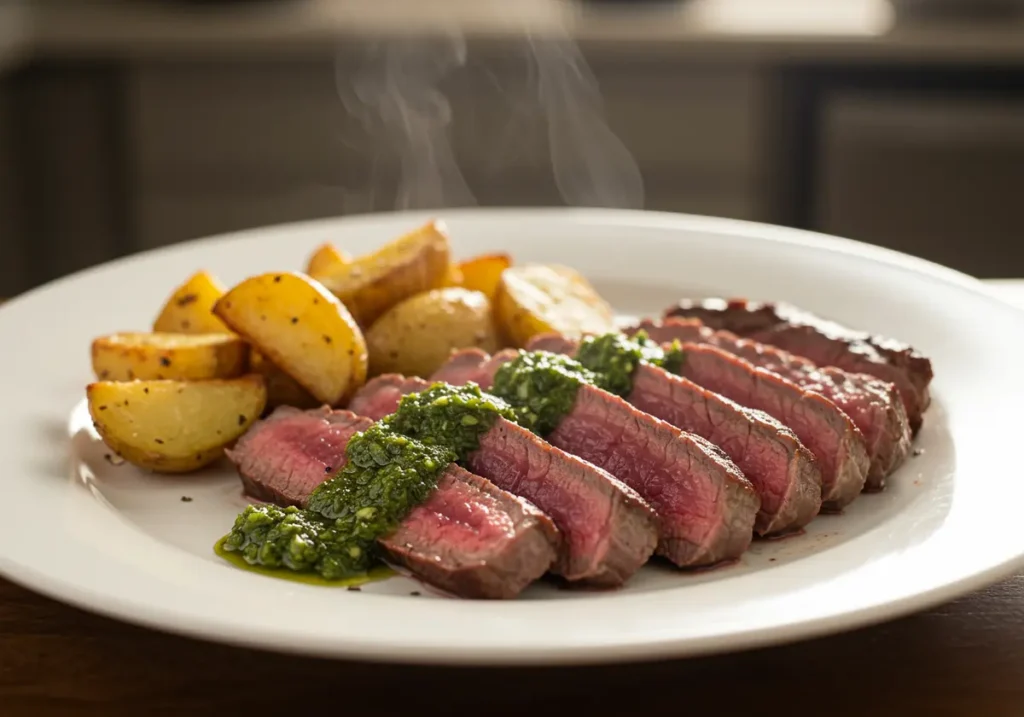If you’ve ever found yourself wondering what a hanger steak is, you’re not alone. It’s one of the most flavorful and misunderstood cuts of beef, often overshadowed by more common options like ribeye or flank. However, it has recently been appearing in restaurants, butcher counters, and foodie conversations across the U.S.
So, what is a hanger steak, exactly? It’s a tender, beefy cut taken from a very specific part of the cow, and there’s only one per animal. That rarity, combined with its rich flavour, is why chefs have loved it for decades. Now, home cooks are catching on, too.
In this article, we’ll help you understand:
- What is hanger steak, and how does it stand out
- It’s located on the cow
- Why it was once the butcher’s best-kept secret
- And how it differs from similar cuts like skirt steak
We’ll also link to helpful guides, such as how to cook hanger steak and how to distinguish it from skirt steak, so you’ll know exactly what to look for and how to use it.
Let’s dive into the basics and uncover the truth about what a hanger steak is and why it deserves your attention.
The Definition of Hanger Steak
Understanding the Cut: What Is a Hanger Steak?
Let’s get straight to the point — what is a hanger steak? It’s a long, flat cut of beef that comes from the cow’s plate section near the front of the belly. This muscle hangs between the rib and loin, connected to the diaphragm, which is exactly where its name comes from.
It’s officially known as the “hanging tenderloin” or “hanging tender,” and unlike many other cuts, there’s only one hanger steak per cow, which is why it’s rare and prized among chefs and butchers alike.
Where It Comes From on the Cow
If you’re trying to visualize what a hanger steak is in terms of anatomy, think of a small, V-shaped muscle suspended from the underside of the cow’s ribs. It doesn’t get much exercise, which is why it’s naturally tender.
Unlike the flank or brisket, which are working muscles and often tougher, the hanger remains soft even without marinating. It has a loose grain that makes it ideal for fast cooking and easy slicing, especially when cut against the grain.
What Makes It Stand Out
What separates this cut from others isn’t just where it comes from. It’s also about flavour. The hanger delivers a deep, beefy taste that many people say is even more intense than ribeye. Combine that with its tenderness, and you’ll understand why it’s a restaurant favourite.
To sum it up, if someone asks what is a hanger steak, you can tell them it’s a rare, flavorful, and tender cut from the cow’s plate section — a perfect blend of simplicity and sophistication.
Anatomy and Location
What Is a Hanger Steak, Anatomically Speaking?
To answer what is a hanger steak?, we need to look at where it comes from inside the cow. This cut originates in the plate section, which is located near the belly and just below the ribs. Specifically, the hanger steak is a long, V-shaped muscle that hangs from the diaphragm, which is how it got its name.
Because of this hanging position and minimal muscle use, the meat stays extremely tender and richly marbled, with a loose, open grain that’s ideal for quick cooking. It’s also known as the hanging tender or hanging tenderloin, which are butcher terms you might see in specialty markets.

Location Compared to Skirt and Flank Steak
Many people ask what a hanger steak is because they confuse it with flank or skirt steak, two neighboring cuts. Though they’re all from the underbelly, each has unique characteristics.
Here’s a visual breakdown of how they differ:
| Cut | Location | Texture | Flavor | Quantity per Cow |
|---|---|---|---|---|
| Hanger Steak | Hangs from the diaphragm | Very tender, loose grain | Bold, beefy | One (very limited) |
| Skirt Steak | Below the ribs | Long, fibrous grain | Intense beef flavor | Two small pieces |
| Flank Steak | Rear abdominal wall | Lean, dense grain | Mild, meaty | One large piece |
Although they look similar raw, once cooked, the hanger has a more melt-in-your-mouth texture and richer flavor.
Why It Matters
Knowing what is a hanger steak anatomically gives you an edge when buying meat. Since there’s only one per cow, it’s not something you’ll find in abundance at every grocery store. If you spot it, grab it — this steak brings restaurant-quality flavor to your home kitchen.
In upcoming sections, we’ll explore how to cook hanger steak the right way and how to avoid mixing it up with skirt or flank again.
Why It’s Called the Butcher’s Cut
A Steak So Good, Butchers Kept It for Themselves
To understand what is a hanger steak?, it helps to look at its nickname: the butcher’s cut. That title isn’t just marketing — it comes from a real tradition in butcher shops across the globe. For decades, meat cutters would quietly set aside this steak for their use rather than offer it for sale.
Why? Because they knew what most customers didn’t: hanger steak delivers top-tier flavor and tenderness without the high price tag of a ribeye or filet. Since there’s only one per cow, it wasn’t easy to sell in bulk anyway, so it became the butcher’s little secret.
From Hidden Gem to Chef Favorite
Over time, word spread. Chefs began to catch on and started featuring it on steakhouse menus, often labeling it as onglet (in French cuisine) or the hanging tender. As demand rose, home cooks also began to ask: What is a hanger steak, and why have I never tried it?
Once people realized how easy it is to prepare and how deeply flavorful it can be, the hanger’s reputation grew. It’s now prized not only for its taste but also for its versatility in everything from tacos to plated entrees.
Today, while it’s no longer a secret, hanger steak still feels like an insider’s choice — the kind of cut that savvy meat lovers keep in rotation.
Alternate Names for Hanger Steak
What Is a Hanger Steak Called Around the World?
If you’ve been asking what is a hanger steak, you may already know it goes by several different names. Depending on where you are — or who you’re talking to — this flavorful cut might be called:
- Onglet (French cuisine)
- Hanging tender (U.S. butchery term)
- Butcher’s steak (nickname from meat cutters)
- Diaphragm steak (due to its anatomical position)
All of these refer to the same long, V-shaped muscle that hangs from the diaphragm, known for its loose grain, bold flavor, and juicy tenderness.
Why So Many Names?
Part of what makes answering “what is a hanger steak?” tricky is the confusion caused by these varied terms. In butcher shops, especially in the U.S., the cut may be labeled as “hanging tenderloin” or just “hanging tender.” French chefs prefer “onglet,” and you’ll often see that name on European menus.
Some grocery stores avoid selling it altogether due to its low yield — there’s only one per cow. Others group it with skirt or flank steak, which adds to the confusion. But once you know how to identify it — by shape, grain, and tenderness — it’s easy to spot.
A True Insider’s Cut
So when someone asks what is a hanger steak, you can let them know it’s one cut with many names — but always the same great flavor. Whether it’s marked as onglet or hanging tender, the key is knowing how to recognize and cook it.
And if you’re still unsure, compare it to skirt steak here to make sure you’re grabbing the right cut.
Common Confusion with Similar Cuts
Is It Skirt, Flank, or Hanger? Here’s How to Tell
If you’ve ever stood at the butcher counter staring at a long, flat cut of meat and thought, “Is that skirt or hanger?” — you’re not alone. Many people looking up what is a hanger steak do so because they’ve confused it with other cuts.
The most common mix-ups happen with skirt steak and flank steak — both of which share a similar shape and location on the cow.
But here’s how they differ:
Side-by-Side Cut Comparison
| Feature | Hanger Steak | Skirt Steak | Flank Steak |
|---|---|---|---|
| Location | Hangs from the diaphragm | Below ribs | Rear abdominal wall |
| Texture | Tender, loose grain | Chewy, fibrous | Lean, dense grain |
| Flavor | Bold and beefy | Intense, minerally | Mild, slightly earthy |
| Quantity per Cow | One | Two | One |
| Best Uses | Grilling, slicing | Fajitas, tacos | Stir-fry, marinades |
If you’re focused on tenderness and flavor, hanger steak is the clear winner. Skirt steak may look similar, but it tends to be chewier and thinner. Flank, while popular, is leaner and lacks the richness that makes hanger a favorite.

Still Unsure? Compare Them in Detail
To really understand what is a hanger steak — and how it holds up next to these similar cuts — we’ve created a full breakdown.
Once you’ve seen the differences up close, you’ll never confuse them again.
Why There’s Only One Per Cow
The Rarest Cut on the Animal
One of the most surprising things you’ll learn when asking what is a hanger steak is this: there’s only one per cow.
Unlike other cuts that come in pairs (like skirt steak or tenderloin), the hanger is a single muscle — the diaphragm’s hanging tender — that stretches along the inside of the rib cage. Because it’s located in a central position and isn’t duplicated on both sides of the animal, the yield is extremely limited.
For butchers, this means hanger steak isn’t a volume-friendly product. It’s not something you can package in bulk or restock easily, which is exactly why it has been treated as a premium insider’s cut for years.
How Scarcity Impacts Price and Availability
Due to its limited availability, hanger steak isn’t always found at chain supermarkets. You’re more likely to find it at local butcher shops, high-end grocers, or through online specialty meat suppliers.
And while it’s often more affordable than ribeye or filet, its price has been climbing steadily, not because it’s fancy, but because there’s just so little of it to go around. Once you understand what a hanger steak is and why there’s only one, the pricing makes perfect sense.
The takeaway? If you see one at your butcher, grab it — fast.
What Makes It Special
Flavor That Rivals More Expensive Steaks
Once you understand what is a hanger steak is, the next question is usually: Why do chefs love it so much? The answer lies in the flavor. Few cuts offer the same rich, beef-forward taste that this one delivers. Often described as bold, slightly iron-rich, and intensely savory, hanger steak holds its own against pricier cuts like ribeye or NY strip.
Its loose muscle structure allows seasoning and marinades to penetrate deeply, which adds even more complexity to the flavor profile. Whether grilled, seared, or served medium-rare with chimichurri, hanger steak always feels like a gourmet-level experience.

Tender, But Not Mushy
Unlike filet mignon, which is soft but mild in flavor, hanger steak strikes a rare balance — tenderness with real character. It’s not melt-in-your-mouth soft, but when sliced against the grain, it offers a satisfying bite with just enough resistance.
If you’ve been wondering what is a hanger steak good for, think of dishes that benefit from bold flavor and texture — steak salads, tacos, sliced steak over roasted vegetables, or plated with a rich pan sauce.
Looking for cooking tips? Check out how to prepare hanger steak perfectly for pro-level results at home.
Why It Belongs in Your Regular Rotation
Despite its growing popularity, hanger steak still flies under the radar in many home kitchens. It’s affordable, easy to cook, and versatile enough for weeknights or special occasions. Once you’ve had it done right, it’s hard to go back.
So the next time someone asks what is a hanger steak, you’ll not only have the answer, you’ll have a new favorite cut.
Understanding Hanger Steak
Is hanger steak the same as skirt steak?
No. Although hanger steak and skirt steak are often confused due to their similar shape, they come from different parts of the cow. Hanger steak hangs from the diaphragm and is more tender, while skirt steak comes from the lower rib area and is chewier with a stronger grain.
Why is it called hanger steak?
It’s called hanger steak because the muscle “hangs” from the cow’s diaphragm. This V-shaped muscle sits inside the ribcage and doesn’t see much movement, making it more tender than nearby cuts. The name is a direct reference to its physical location.
What does hanger steak taste like?
Hanger steak has a bold, beefy flavor that many compare to ribeye, but without as much fat. It’s slightly iron-rich, savory, and pairs well with strong seasonings or sauces like chimichurri or red wine reductions.
Is hanger steak expensive?
It’s moderately priced — often cheaper than ribeye but more expensive than flank. Since there’s only one hanger steak per cow, it’s rare, and pricing reflects that. Still, it offers great value considering its flavor and tenderness.
Is hanger steak healthy?
Yes, when consumed in moderation. Hanger steak is high in protein, iron, and essential nutrients. It’s leaner than some high-fat cuts like ribeye, making it a good choice for those watching fat intake while still craving strong flavor.
Why Hanger Steak Deserves a Place in Your Kitchen
Now that you understand what a hanger steak is, it’s easy to see why it’s been a favorite among butchers, chefs, and steak lovers for decades. With its rich flavor, tender texture, and rare availability, this cut offers a unique eating experience that few others can match.
It might not be as well-known as ribeye or filet mignon, but that’s part of the appeal. Hanger steak is a hidden gem — a cut that delivers restaurant-quality flavor without the hefty price tag, if you know where to find it and how to cook it right.
From its distinct anatomy to its many aliases like onglet and hanging tender, this steak stands out not just for how it tastes, but for the story it tells. It’s the butcher’s secret that’s finally out — and now it’s your turn to make it a regular part of your home cooking lineup.

